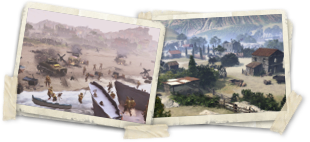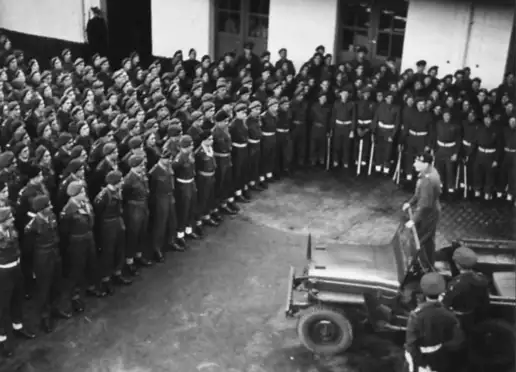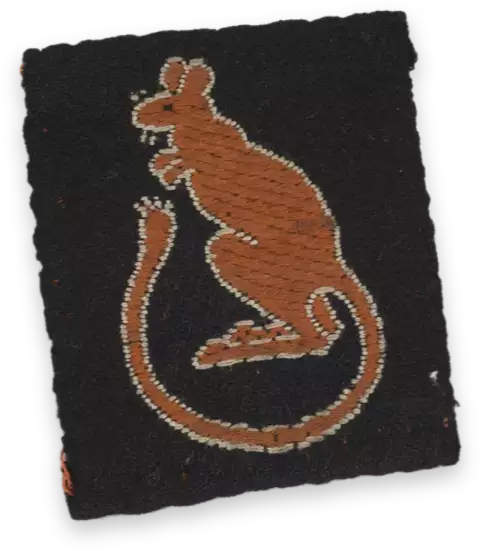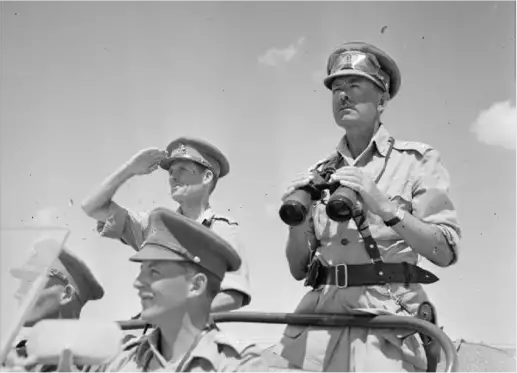
 Experience the dynamic campaign in game with
Experience the dynamic campaign in game with 
 Find out more
Find out moreSecuring a hard-earned victory in the most unforgiving of conditions, a group of British soldiers have gone down in history as some of the most tenacious desert fighters of all time.
The Desert Rats of the British Army’s 7th Armoured Division fought in the North Africa campaigns of WW2, helping to bring about the momentous defeat of Nazi Germany’s Afrika Korps.
From the officer who sent vital communications in the middle of Sahara sandstorms, to the decorated soldier who later befriended Rommel’s son, we explore the fascinating true stories gleaned from historical records – and discover the brave names who made the extraordinary possible.
Founded in the arid desert of North Africa, the Desert Rats of the British 8th army fought in some of the most pivotal campaigns of WW2.
The British kept a relatively small combat force in Egypt prior to the rising tensions that foreshadowed WW2. Following the Munich Crisis of 1938, however, this group grew and became known as the Mobile Division (Egypt), later forming the 7th Armoured Division in 1940.
It was no secret that the British Army needed to build its strength and numbers to protect the Egyptian frontier – and the strategically vital Suez Canal.
By 1941, the 7th Armoured Division had become one of the original forces at the core of the legendary British 8th Army, continuing the North African campaign alongside the 4th Indian Division.

Montgomery addressing Desert Rats
Although they officially disbanded in the 1950s, their legacy continues to this day thanks to the 7th Infantry Brigade and HQ East. Carrying the same red and white badge from WW2 on their uniforms, the Desert Rats live on!

7th Armoured Division Badge
The Desert Rats had a long list of generals to look up to during WW2, and across the division’s 20-year lifespan.

Field Marshal Allen Francis “John” Harding, 1st Baron Harding of Petherton, GCB CBE DSO MC.
Brought in by Lieutenant-General Bernard Montgomery himself, Harding took command of the 7th Armoured Division in September 1942. It was he who then led the Desert Rats in the pivotal Second battle of El Alamein, between October and November that year.
“Harding is one of the stars of the British Army… When Montgomery arrives in North Africa in August 1942, his original idea is to create something which is like the German Africa Korps.”
- Prof Ball
Badly wounded in action at the start of 1943, it is likely a sign of his renowned determination that Harding later returned under General Sir Harold Alexander, to take part in the Italian campaign as chief of staff. He played a major role in planning Operation Diadem, also known as the fourth battle of Monte Cassino.
After the war, Harding’s reward was to succeed Alexander as commander of the British forces in the Mediterranean in 1946, later becoming Chief of the Imperial General Staff in 1952.

Major-General George Philip “Pip” Bradley Roberts, CB DSO MC.
Spearhead of the Desert Rats’ 22nd Armoured Brigade, Pip Roberts was undoubtedly one of the most skilled tank leaders of the British Army.
Roberts helmed the Brigade through the battles of Alam el Halfa and El Alamein. An impressive achievement, given that Roberts’ day job was not what you might expect.
In his civilian life, Pip Roberts was in fact a director of Huntley and Palmers biscuit makers.
“Roberts describes himself not as a soldier, but as a biscuit maker!”
- Prof Ball
Following Harding’s serious injury, Roberts briefly took on the role of acting General Officer of the 7th Armoured Division in January 1943.
Later, he went on to command the 11th Armoured Division in North-West Europe in December 1943, helping the Allies secure another pivotal victory in the battle of Normandy.
Field Marshal Richard Michael Power Carver, GCB CBE DSO MC.
Michael Carver might be one of the most iconic names of the British Army – and the Desert Rats in particular.
Fighting in the North African campaign, he served on Harding’s staff at the Headquarters of the 7th Armoured Division, before rising to senior staff officer to the Desert Rats in 1942.
April 1943 however is when Carver really came into his own, becoming the commanding officer of the 1st Royal Tank Regiment, where he won his first Distinguished Service Order (DSO) medal in recognition of a complicated reconnaissance mission prior to the Battle of El Alamein.
His experience then led him to the battles of Salerno and Normandy, before he took charge of the 4th Independent Armoured Brigade, eventually pushing all the way into northern Germany.
After the war, Carver branched out with a triple career – rising through the ranks as one of Britain’s most successful commanders, while simultaneously building his reputation as a theorist of war and an acclaimed historian. He even wrote Field Marshal John Harding’s biography.
Writing and publishing detailed accounts of the battle of El Alamein, it is perhaps fitting that Carver himself helped immortalise the experiences and deeds of the army’s Desert Rats.
It’s important to remember, of course, that those who served in WW2’s desert campaigns belonged to various forces from various nations, fighting alongside the 7th Armoured Division as part of the Desert Army. “Desert Rat” soon became a colloquial term, often used to describe an array of brave veterans who fought in the desert campaign.
The Australian-led Rats of Tobruk, for example, also share a common sense of heroism in their defence of that city.
After joining the army in 1937 in Norfolk, the young man who would one day become Major Freddie Hunn served as a radio operator in the 12th Royal Lancers during WW2. Keen to join the regiment, as an admirer of their armoured cars, he was quickly promoted to Lance Corporal within six months. At this point, he had no idea what to expect of the war to come.
After being sent to the Battle of France and supporting the retreat to Dunkirk, the 12th Royal Lancers were eventually deployed to North Africa in late 1941. Hunn travelled north from South Africa to commence their contact with Rommel.
Reaching North Africa, the regiment then met up with the Desert Rats of the 7th Armoured Division. The 12th Royal Lancers’ first task was to escort Lieutenant-General William “Strafer” Gott around the front line. Throughout the mission, Axis anti-tank guns opened fire on Hunn’s regiment, while Stuka bombs screamed down from the heavens.
Consequences to these attacks and air raids went beyond casualties. Many soldiers suffered with what was dubbed at the time as ‘shell shock’ – which we would today recognise as PTSD. In addition, the wreckage left armoured cars looking like a scrap yard, with water supplies and rations also destroyed.
The 12th Royal Lancers fought alongside the Desert Rats in the battles of Gazala, Alam el Halfa, El Alamein and Tunis.
In 1938, Alex Macintyre met Nan Smith in the Albert Ballroom in Glasgow.
The young pair danced the night away, and were soon a local item. With Macintyre a lather in the building trade and Nan a sales clerk in a shoe shop, they planned to marry and settle down like many other sweethearts of the time.
Then, the war broke out in 1939.
Macintyre, throughout his service in North Africa and the Italian campaign, wrote home to Nan as often as he could. Some 60 years later, their daughter Liz would stumble across a small suitcase and a box full of 300 letters. These provided the springboard to bring their love story to life in a published book – Love Letters from a Desert Rat.
Macintyre sailed down the African west coast with the British 8th Army, and travelled to Egypt for the battle against Rommel and the Afrika Korps, where he became a Gunner in 1942.
His letters touch upon many things. The jealousy of watching as other soldiers call their partners at home while he misses Nan. The daily pestering of insects and sandstorms. The peculiarity of writing heartfelt letters to the love of his life, knowing that someone else will read them first.
Wedding anniversaries and Christmases pass by, with letters to Nan back in Scotland expressing the hope that he will be home by the next one.
On December 25, 1941, he muses:
“Seems strange that I should be writing to you from here in the desert during Christmas Day. This period of the year when one is reminded of ‘Peace on Earth’ and yet looking around at present surroundings one sees nothing that is not connected with war and with destruction”.
It’s worth noting that Nan returned just as many letters to her husband while he was at war.
Macintyre’s correspondence offers us a deeply personal account of the tough life of a desert soldier – and the legacy of a true WW2 Desert Rat.
Did you know?
According to Alex Macintyre’s love letters, soldiers received the following in their army enrolment kits:
©Relic Entertainment. All rights reserved. Developed by Relic Entertainment. Entertainment, the Relic Entertainment logo, Company of Heroes and the Company of Heroes logo are either registered trademarks or trademarks of Relic Entertainment. Relic Entertainment is registered in the U.S. Patent and Trademark Office. All other trademarks, logos and copyrights are property of their respective owners.